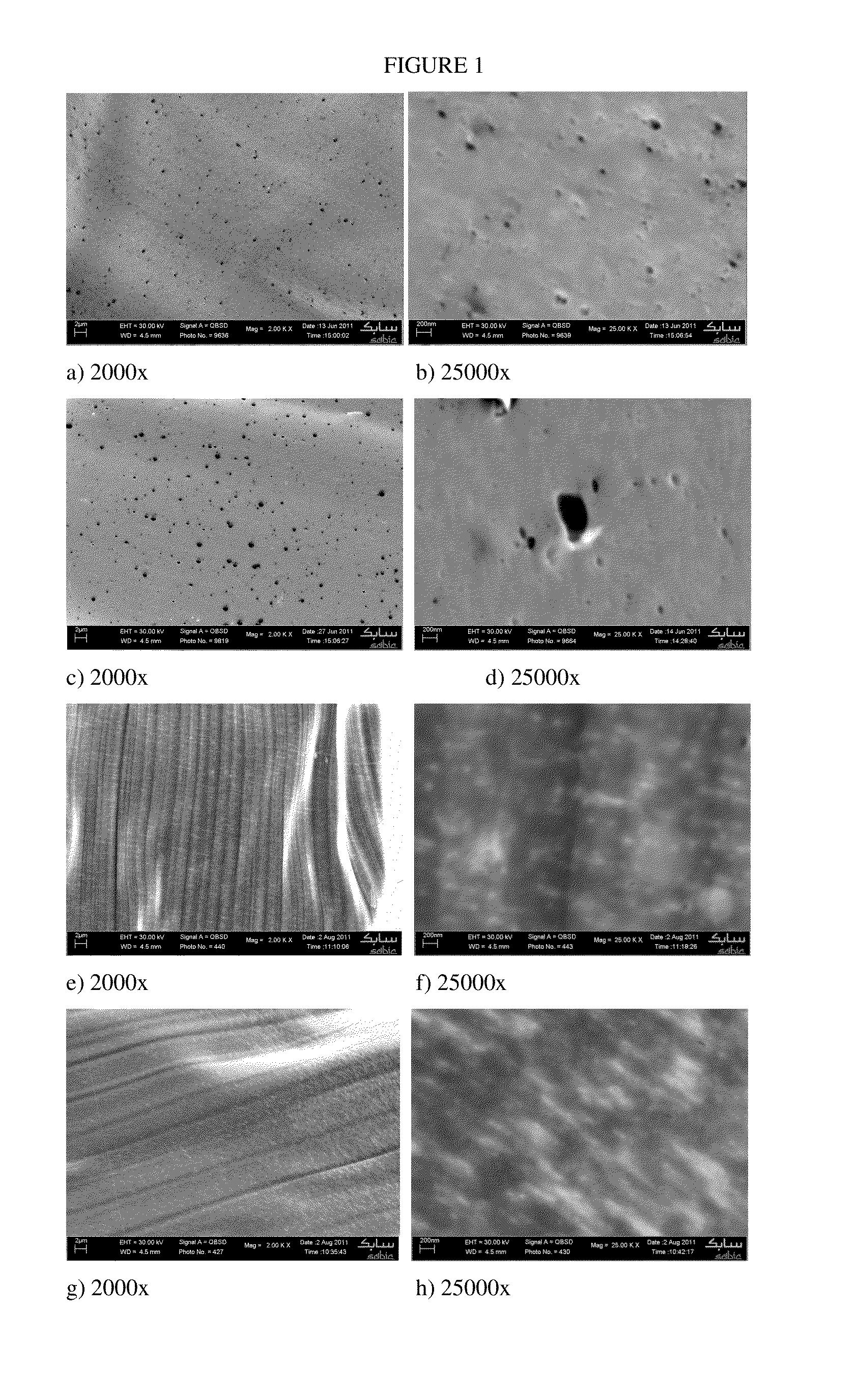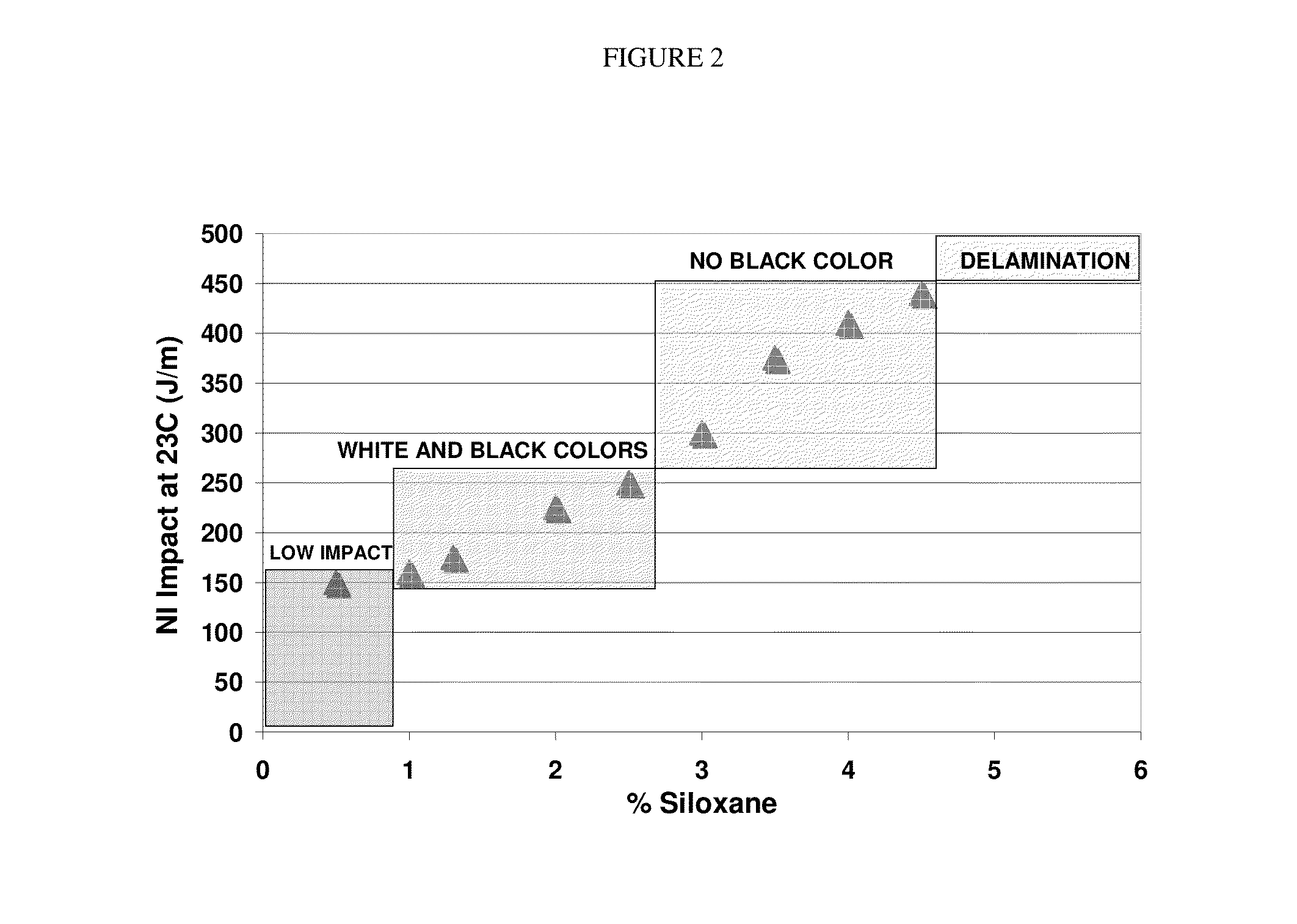High heat polycarbonate and siloxane copolycarbonate blends that provide ductile high heat options for flame retardant applications
- Summary
- Abstract
- Description
- Claims
- Application Information
AI Technical Summary
Benefits of technology
Problems solved by technology
Method used
Image
Examples
Example
Example 1
BPA Copolycarbonate / 20% Siloxane PC (Polycarbonate) Copolymer Blends
[0241]Various blends of PPPBP / BPA copolycarbonate with polysiloxane block copolycarbonate and with BPA polycarbonate were formed, according to formulations specified in Tables 1 and 2. BPA copolycarbonate / siloxane based polycarbonate copolymer blends (a 20% siloxane content in the polycarbonate polysiloxane copolymer (“SiPC1”)), according to the formulations specified below in Tables 1 and 2, were tested for various attributes, such as heat resistance, and impact strength. Delamination and surface defects were also noted in molded articles from these formulations, as indicated in Tables 2 and 3. Delamination was determined based on visual inspection for surface imperfections and appearance.
TABLE 1Formulation for a 20 wt % Siloxane Based BlendAmount inName of Polymer / KilogramsIngredientDescription(KG)PPPBP / BPACo-PC made from 35 wt % (65 wt %64.00Copolymer (CoPC)BPA with molecular wt (Mw) of25,000 (25K) MwSi-...
Example
Example 2
Synthesis of PPPBP / BPA
[0249]PPPBP / BPA was synthesized in the following manner PPPBP monomer (2075 g, 5.27 mol), 33% aqueous sodium hydroxide (1407 g, 11.6 mol) and deionized (DI) water (4818 g) were combined in a tank and agitated until a solid free solution was obtained. The PPPBP monomer solution was transferred to a reactor addition pot. To the formulation tank was added dichloromethane (15 liters (L)), DI water (8 L), bisphenol-A (2425 g, 10.6 mol), para-cumylphenol (160 g, 0.75 mol), triethylamine (30.0 g, 0.30 mol) and sodium gluconate (10 g, iron scavenger). The formulation mixture was stirred then transferred to the batch reactor. The formulation tank was rinsed with dichloromethane (5 L) which was transferred to the batch reactor. The reactor agitator was started and the circulation flow was set at 80 L / min. Phosgene vapor flow to the reactor was initiated by the DCS at 80 g / min. Addition of the PPPBP monomer solution was initiated and controlled by the DCS at 830 ...
Example
Example 3
Synthesis of SIPC1
[0252]SiPC1 was synthesized in the following manner. Dichloromethane (15 L), DI water (10 L), bisphenol-A (3700 g, 16.2 moles), E45 (i.e., an average siloxane chain of 45 repeating units) eugenol siloxane (1150 g, 0.30 mole), triethylamine (30 g, 0.30 mole, 1.7 mole %) and sodium gluconate (10 g, iron scavenger) was added to a formulation tank. The mixture was stirred and transferred to the batch reactor. The formulation tank was rinsed with dichloromethane (5 L), and transferred to the batch reactor. The reactor agitator was started and the circulation flow was set at 80 L / min. Phosgene vapor over the reactor was initiated by the DCS (segment 1: 215 g, 80 g / min rate). The pH of the reaction was maintained at a target of 10.0 by a distributed control system (“DCS”) controlled addition of 33% aqueous NaOH. After addition of 215 g of phosgene, a solution of PCP (116 g, 0.55 mole) in dichloromethane was added to the reactor by DCS control while phosgene flow ...
PUM
| Property | Measurement | Unit |
|---|---|---|
| Temperature | aaaaa | aaaaa |
| Temperature | aaaaa | aaaaa |
| Temperature | aaaaa | aaaaa |
Abstract
Description
Claims
Application Information
 Login to view more
Login to view more - R&D Engineer
- R&D Manager
- IP Professional
- Industry Leading Data Capabilities
- Powerful AI technology
- Patent DNA Extraction
Browse by: Latest US Patents, China's latest patents, Technical Efficacy Thesaurus, Application Domain, Technology Topic.
© 2024 PatSnap. All rights reserved.Legal|Privacy policy|Modern Slavery Act Transparency Statement|Sitemap



